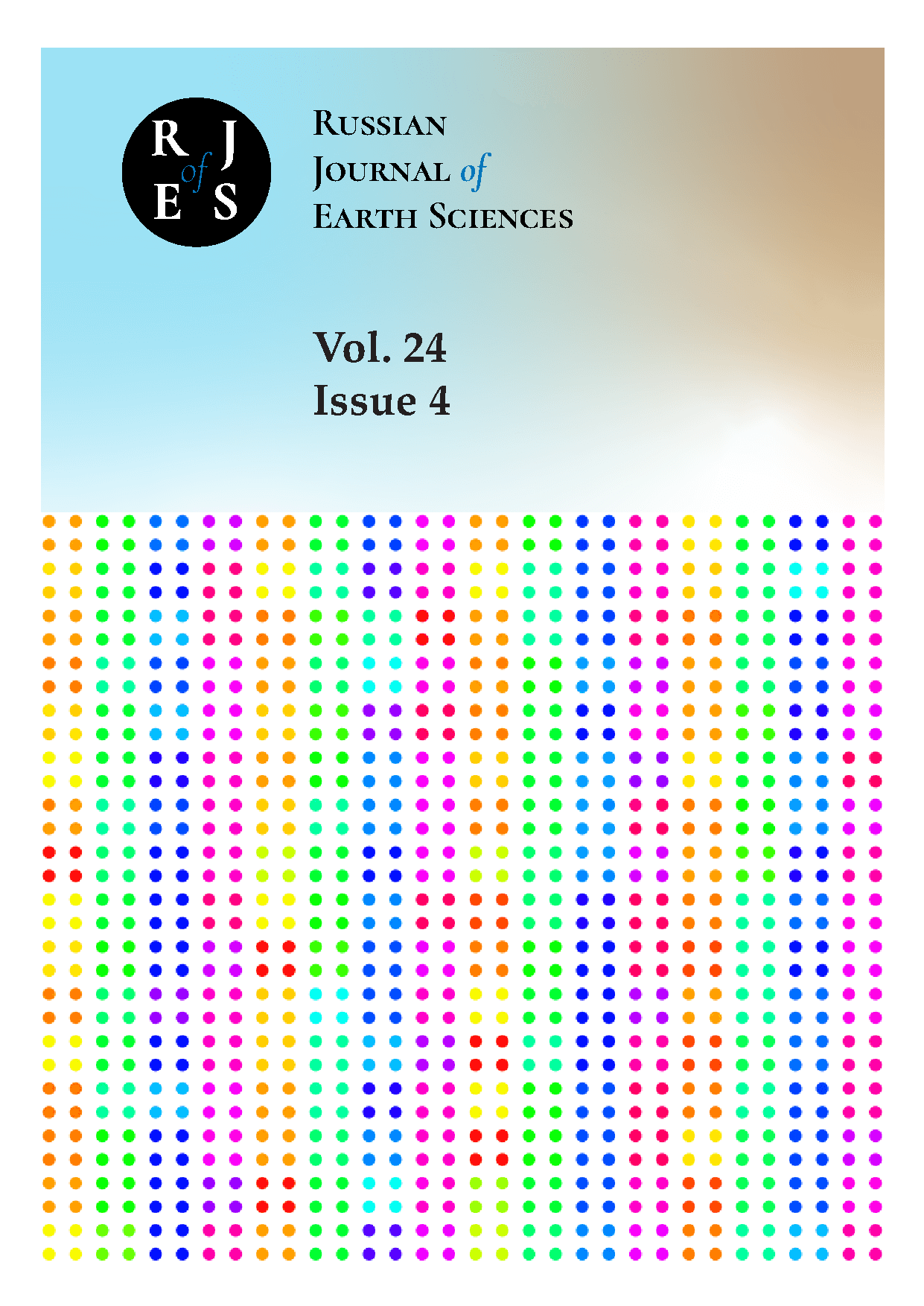from 01.01.2021 until now
Vidnoe, Moscow, Russian Federation
Moscow, Russian Federation
Institut geohimii i analiticheskoy himii imeni V.I. Vernadskogo RAN
Geologicheskiy institut RAN
UDC 551.83
UDC 550.422
UDC 550.428
UDC 550.462
UDC 55
UDC 550.34
UDC 550.383
CSCSTI 37.01
CSCSTI 37.15
CSCSTI 37.25
CSCSTI 37.31
CSCSTI 38.01
CSCSTI 36.00
CSCSTI 37.00
CSCSTI 38.00
CSCSTI 39.00
CSCSTI 52.00
Russian Classification of Professions by Education 05.00.00
Russian Library and Bibliographic Classification 26
Russian Trade and Bibliographic Classification 63
BISAC SCI SCIENCE
The features of the mineral and chemical composition (major elements) of the Vendian-Cambrian rocks of the Silimkun Formation (V-Є1sl), exposed on the western side of the Upper Kalar graben syncline in the southwest of the Aldan shield, are considered. The studied rocks – sandstones and siltstones, belong to arkoses and subarkoses. According to their chemotype, they correspond normosilites and myosilites. In terms of the alkaline modulus, the studied silites are hyperpotassium and serve as a fairly striking example of the products of Precambrian arid weathering. The standard mineral composition, its variations, the validity of calculations based on petrographic research data, the problems of using climate indices and lithochemical diagrams aimed at reconstructing climatic changes in the geological past are discussed. Chemical Index of Alteration (CIA) index values range from 49, which corresponds to a virtually unchanged rock, to 67. The average is about 58. Minor changes in the index value for this sample are associated primarily with variations in the content of illite cement and muscovite. Robust Weathering index (RW) values range from 37 to 68 (with an average of about 57).
Ediacaran, Cambrian, Udokan region, climate, chemical weathering proxies
1. Babechuk M. G., Fedo C. M. Analysis of chemical weathering trends across three compositional dimensions: applications to modern and ancient mafic-rock weathering profiles // Canadian Journal of Earth Sciences. — 2023. — Vol. 60, no. 7. — P. 839–864. — DOI:https://doi.org/10.1139/cjes-2022-0053.
2. Cho T., Ohta T. A robust chemical weathering index for sediments containing authigenic and biogenic materials // Palaeogeography, Palaeoclimatology, Palaeoecology. — 2022. — Vol. 608. — P. 111288. — DOI:https://doi.org/10.1016/j.palaeo.2022.111288.
3. Dolnik T. A. Stromatolites and microphytolites in the stratigraphy of the Riphean and Vendian folded frame of the Siberian platform. — Novosibirsk : Nauka, 2000. — P. 320.
4. Fedo C. M., Babechuk M. G. Petrogenesis of siliciclastic sediments and sedimentary rocks explored in three-dimensional Al2O3-CaO*+Na2O-K2O-FeO+MgO (A-CN-K-FM) compositional space // Canadian Journal of Earth Sciences. — 2023. — Vol. 60, no. 7. — P. 818–838. — DOI:https://doi.org/10.1139/cjes-2022-0051.
5. Fedo C. M., Wayne Nesbitt H., Young G. M. Unraveling the effects of potassium metasomatism in sedimentary rocks and paleosols, with implications for paleoweathering conditions and provenance // Geology. — 1995. — Vol. 23, no. 10. — P. 921. — DOI:https://doi.org/10.1130/0091-7613(1995)023<0921:UTEOPM>2.3.CO;2
6. Guo Y., Yang S., Su N., et al. Revisiting the effects of hydrodynamic sorting and sedimentary recycling on chemical weathering indices // Geochimica et Cosmochimica Acta. — 2018. — Vol. 227. — P. 48–63. — DOI:https://doi.org/10.1016/j.gca.2018.02.015.
7. Lécuyer C. Seawater residence times of some elements of geochemical interest and the salinity of the oceans // Bulletin de la Société Géologique de France. — 2016. — Vol. 187, no. 6. — P. 245–260. — DOI:https://doi.org/10.2113/gssgfbull.187.6.245. EDN: https://elibrary.ru/ONUNFT
8. Lo F.-L., Chen H.-F., Fang J.-N. Discussion of Suitable Chemical Weathering Proxies in Sediments by Comparing the Dissolution Rates of Minerals in Different Rocks // The Journal of Geology. — 2017. — Vol. 125, no. 1. — P. 83–99. — DOI:https://doi.org/10.1086/689184.
9. Makaryev L. B., Mitrofanov G. L., Mitrofanova N. N., et al. State Geological Map of the Russian Federation, scale 1:1,000,000 (third generation). Aldan-Zabaykalskaya Series. Sheet O-50 - Bodaibo. Explanatory Note. — St. Petersburg : VSEGEI Cartographic Factory, 2010. — P. 612. EDN: https://elibrary.ru/RRRDRB
10. McLennan S. M. Weathering and Global Denudation // The Journal of Geology. — 1993. — Vol. 101, no. 2. — P. 295– 303. — DOI:https://doi.org/10.1086/648222. DOI: https://doi.org/10.1139/cjes-2022-0053; EDN: https://elibrary.ru/IYZYEY
11. Nesbitt H. W., Young G. M. Early Proterozoic climates and plate motions inferred from major element chemistry of lutites // Nature. — 1982. — Vol. 299, no. 5885. — P. 715–717. — DOI:https://doi.org/10.1038/299715a0. DOI: https://doi.org/10.1016/j.palaeo.2022.111288; EDN: https://elibrary.ru/TMJLER
12. Pakhomov N. N., Barabasheva E. E. New data on the stratigraphy and fauna of Vend-Lower Cambrian deposits of Upper-Kalar Graben // New data on palaeozoic and mesozoic biostratigraphy of the south Far East. — Vladivostok : Far Eastern Branch of the USSR AS, 1990. — P. 24–31. DOI: https://doi.org/10.1139/cjes-2022-0051; EDN: https://elibrary.ru/ICNHTS
13. Pettyjohn F. J., Potter P., Seaver R. Sands and Sandstones. — Moscow : World, 1976. — P. 535.
14. Regelink J. A. Mincomp-a program to calculate a likely mineralogical bulk composition from XRD and XRF results. Research Minor TA-MI-077. — Delft University of Technology, 2014.
15. Rosen O. M., Abbyasov A. A. The Quantitative Mineral Composition of Sedimentary Rocks: Calculation from Chemical Analyses and Assessment of Adequacy (MINLITH Computer Program) // Litologiya i Poleznye Iskopaemye. — 2003. — No. 3. — P. 299–312. DOI: https://doi.org/10.2113/gssgfbull.187.6.245; EDN: https://elibrary.ru/YXREXN
16. Rosen O. M., Abbyasov A. A., Migdisov A. A., et al. MINLITH - a program to calculate the normative mineralogy of sedimentary rocks: the reliability of results obtained for deposits of old platforms // Geochemistry International. — 2000. — Vol. 38, no. 4. — P. 388–400.
17. Rosen O. M., Abbyasov A. A., Tipper J. C. MINLITH-an experience-based algorithm for estimating the likely mineralogical compositions of sedimentary rocks from bulk chemical analyses // Computers & Geosciences. — 2004. — Vol. 30, no. 6. — P. 647–661. — DOI:https://doi.org/10.1016/j.cageo.2004.03.011.
18. State Geological map of the Russian Federation scale 1:200000. Second edition. Udokan series. O-50-XXXV(Naminga) / ed. by G. L. Mitrofanova. — VSEGEI, 2004.
19. State Geological Map of the Russian Federation, scale 1:1,000,000, new series, sheet O-(50) 51 and explanatory note / ed. by E. P. Mironyuk. — St. Petersburg. : VSEGEI, 1998. — P. 428.
20. Yudovich Y. E., Ketris M. P. Fundamentals of Lithochemistry. — St. Petersburg : Science, 2000. — P. 479.
















